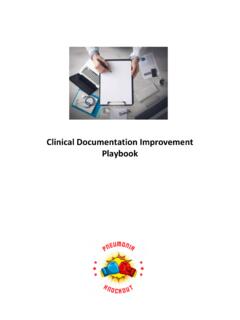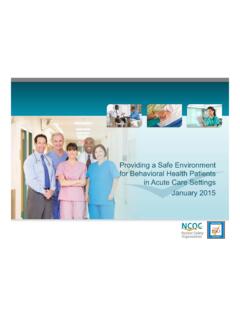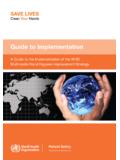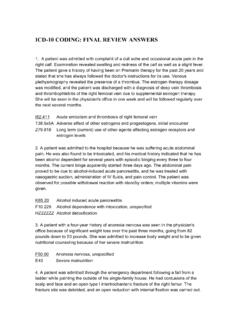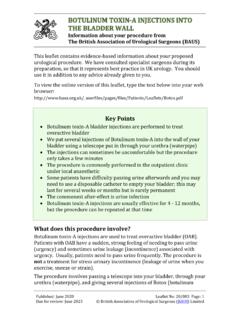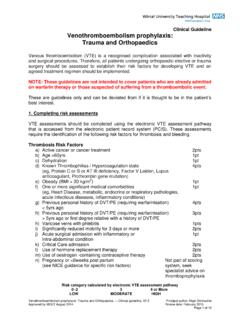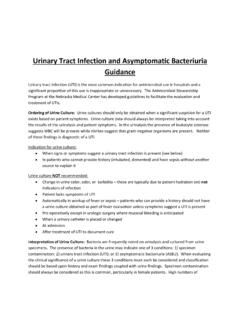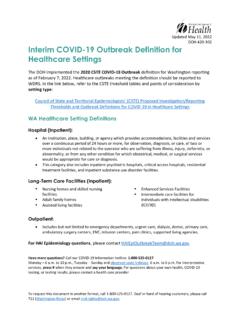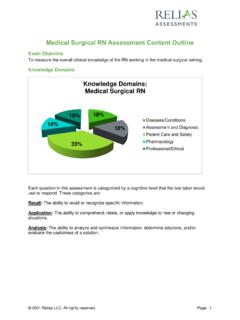Transcription of How to Conduct a Medical Record Review - NCHA
1 WHITE PAPERHow to Conduct a Medical Record ReviewzFEATURES Aligning Record reviews to organizational goals ..2 Principles of Record Review ..3 ED/EMS notes ..5 History and physical (H&P) ..6 Operative note or bedside procedures ..7 Diagnostics and medications ..8 Progress notes, consults, and nursing documentation ..9 Initial vs. subsequent reviews ..9 Documenting the Review : capturing thought processes and critical thinking ..11 Reconciliation with coded data ..13 Advanced techniques for mature CDI programs ..15 The role of technology ..17 Conclusion ..18 References ..19 Medical Record Review is perhaps the core responsibility of the CDI profession-al. Although the numbers vary by facility, CDI specialists Review an average of 16 24 patient charts daily, a task that compromises the bulk of their workday (ACDIS, 2016).
2 1 During the Review , CDI professionals comb the chart for incom-plete, imprecise, illegible, conflicting, or absent documentation of diagnoses, procedures, and treatments, as well as supporting clinical indicators. Their goal is to cultivate a Medical Record that stands alone as an accurate story of a patient encounter, providing a full picture of the patient s illness and Record of treatment. A complete Record allows for continuity of care, reliable collection of mortality and morbidity data, quality statistics, and accurate reimbursement. In their Review of the Medical Record , CDI professionals aim to reconstruct the patient story from admission to discharge by examining, understanding, and synthesizing many puzzle pieces from disparate systems and people.
3 This process requires considerable clinical acumen, critical thinking akin to detective work, and knowledge of coding guidelines and quality measure requirements. In a world with finite resources, it also requires an efficient, effective workflow. This paper defines a recommended process for Medical Record Review . This includes the important first step of defining the why behind the Review , and marrying the Review outcome to organizational goals. The paper also describes a recommended step-by-step Review process, starting with emergency department documentation and continuing to the history and physical, progress notes, and query and follow-up. This paper defines and differentiates initial and subsequent reviews and offers suggestions for capturing not just physicians critical thinking, but that of the CDI specialists too.
4 It also discusses reconciliation of coded data, advanced chart Review techniques, and the present state of assistive The majority (53%) of respondents to ACDIS 2016 CDI Productivity Survey indicated that they Conduct 6 10 new reviews each day, with 32% reporting that they Conduct 11 15 new reviews each day. Survey results indicated an interesting split of daily re-reviews, with approximately one-third of respondents conducting 6 10 re-reviews per day and one-third conducting 11 15 re-reviews per : This paper defines a recommended process for Medical Record Review . This includes the important first step of defining the why behind the Review , and marrying the Review outcome to organizational 2018 | 2 2018 by HCPro an brand, Any reproduction is strictly prohibited.
5 For more information, call 877-233-8734 or visit to Conduct a Medical Record ReviewAligning Record reviews to organizational goalsOne of the greatest challenges to identifying an optimal, universal CDI Record Review process is contending with differing organizational CDI scopes of work. While this paper offers a standard Review process, differing organizational end goals may require different Review CDI programs began with a goal of DRG optimization. Under this model, CDI specialists typically reviewed the Record concurrent with the patient s stay. Reviews terminated when the DRG was optimized with documentation of the appropriate principal diagnosis.
6 Unfortunately, this approach could lead to busy clinicians missing or omitting comorbidities in the documentation, resulting in an inaccurate patient classification in the DRG system. Today, CDI has evolved. It s no longer focused solely on MS-DRGs, but takes a holistic view of all aspects of patient comorbidities, including the impact on reporting of quality measures and patient conditions . In today s model, CDI reviewers examine cases throughout an encounter and query for documentation of all comorbid conditions , regardless of whether the DRG has already been optimized. This model encourages providers to document all conditions being monitored and treated, thereby ensuring accurate reimbursement for MS-DRG payers and helping prevent denials that stem from the removal of a sole CC/MCC.
7 The model also allows for some risk adjustment that may impact APR-DRG payers and specific quality reporting agency measures. CDI specialists operating in APR-DRG environments typically Review records and query for diagnoses that impact APR-DRG assignment and severity of illness (SOI) and risk of mortality (ROM) metrics, which drive payment and related quality measures. Programs that Review Value-Based Purchasing quality measures focus on principal diagnosis assignment, and on diagnoses (primarily chronic conditions ) that drive risk adjustment for these measures. Ultimately, CDI specialists should Review all records, regardless of payer, to ensure documentation integrity across all patient Review processes may also focus on some combination of the following objectives: Patient Safety Indicators (PSI) hospital - acquired conditions (HAC) Mortality risk: Observed vs.
8 Expected metrics Specific populations (by payer, service line, primary diagnosis, mortalities)Today, CDI has evolved. It s no longer focused solely on MS-DRGs, but takes a holistic view of all aspects of patient comorbidities, including the impact on reporting of quality measures and patient 2018 | 3 2018 by HCPro an brand, Any reproduction is strictly prohibited. For more information, call 877-233-8734 or visit to Conduct a Medical Record Review Hierarchical Condition Categories (HCC) Readmissions and social determinants of health Length of stay (LOS): Observed vs. expected metrics, which can also be risk-adjustedSetting a clear goal for CDI Record Review requires knowledge of reimbursement, quality measures, and other key targets.
9 But it also requires understanding your organization s overall mission and goals. Without this concordance, a CDI program may find itself undervalued by hospital leadership or fail to meet organizational needs. For example, initiating SOI/ROM-focused reviews when hospital leadership is focused on Value-Based Purchasing metrics may result in outcomes misaligned with institutional goals. Merging organizational goals with CDI workflows can be difficult, as it requires access to leadership and negotiation with the competing interests of other departments. As a result, programs often omit this essential step. However, successful alignment can ensure that the organization s priorities are reflected in the CDI program s outcomes, granting the program and its work substantial added value.
10 Communication is of Record reviewA baseline CDI Record Review is a concurrent Review of an inpatient Medical Record in which the CDI specialist attempts to abstract key information for the purposes of quality measurement, compliant coding, and appropriate reimbursement. This process ensures that all conditions being monitored and treated during the encounter are appropriately identified in provider documentation. Quality measurement aspects of the Review include capturing documentation that may need further clarification, require clinical validation, or impact organizational quality measures, patient care and outcomes, and public reporting. Compliant coding reviews identify diagnoses, conditions , and key findings that need further clarification for acuity (acute, subacute, chronic), specificity (type, degree, level), or clinical validation and/or support in order to be properly reported in coded data.

